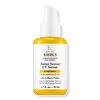What's inside
What's inside
 Key Ingredients
Key Ingredients

 Benefits
Benefits

 Concerns
Concerns

 Ingredients Side-by-side
Ingredients Side-by-side

Butyl Methoxydibenzoylmethane 3%
UV AbsorberHomosalate 7%
Skin ConditioningEthylhexyl Salicylate 5%
UV AbsorberOctocrylene 7%
UV AbsorberWater
Skin ConditioningGlycerin
HumectantC15-19 Alkane
SolventPropanediol
SolventC12-22 Alkyl Acrylate/Hydroxyethylacrylate Copolymer
StabilisingTocopherol
AntioxidantSodium Stearoyl Glutamate
CleansingButylene Glycol
HumectantCetearyl Alcohol
EmollientSclerotium Gum
Emulsion StabilisingHydroxyacetophenone
AntioxidantCaprylyl Glycol
EmollientSodium Starch Octenylsuccinate
AbsorbentGlyceryl Stearate
EmollientJojoba Esters
EmollientHelianthus Annuus Seed Wax
Skin ConditioningHydroxypropyl Starch Phosphate
Trisodium Ethylenediamine Disuccinate
Carbomer
Emulsion StabilisingSodium Lactate
BufferingSodium Hydroxide
BufferingPolysorbate 20
EmulsifyingPolyglycerin-3
HumectantPalmitoyl Tripeptide-1
Skin ConditioningPalmitoyl Tetrapeptide-7
Skin ConditioningButyl Methoxydibenzoylmethane 3%, Homosalate 7%, Ethylhexyl Salicylate 5%, Octocrylene 7%, Water, Glycerin, C15-19 Alkane, Propanediol, C12-22 Alkyl Acrylate/Hydroxyethylacrylate Copolymer, Tocopherol, Sodium Stearoyl Glutamate, Butylene Glycol, Cetearyl Alcohol, Sclerotium Gum, Hydroxyacetophenone, Caprylyl Glycol, Sodium Starch Octenylsuccinate, Glyceryl Stearate, Jojoba Esters, Helianthus Annuus Seed Wax, Hydroxypropyl Starch Phosphate, Trisodium Ethylenediamine Disuccinate, Carbomer, Sodium Lactate, Sodium Hydroxide, Polysorbate 20, Polyglycerin-3, Palmitoyl Tripeptide-1, Palmitoyl Tetrapeptide-7
Zinc Oxide 16%
Cosmetic ColorantWater
Skin ConditioningButyloctyl Salicylate
Skin ConditioningDimethicone
EmollientCaprylic/Capric Triglyceride
MaskingGlycerin
HumectantCoconut Alkanes
EmollientLauryl Polyglyceryl-3 Polydimethylsiloxyethyl Dimethicone
Skin ConditioningVaccinium Vitis-Idaea Fruit Extract
AntioxidantFerulic Acid
AntimicrobialHippophae Rhamnoides Fruit Extract
Skin ConditioningArctostaphylos Uva-Ursi Leaf Extract
Skin ConditioningAloe Barbadensis Leaf Juice
Skin ConditioningQuercetin
AntioxidantTocopherol
AntioxidantTocopheryl Acetate
AntioxidantXanthophylls
Skin ConditioningSucrose
HumectantEthylhexylglycerin
Skin ConditioningLecithin
EmollientPolyglutamic Acid
Skin ConditioningTapioca Starch
Calcium Gluconate
HumectantDimethicone/Polyglycerin-3 Crosspolymer
CleansingTriheptanoin
Skin ConditioningXanthan Gum
EmulsifyingPolyhydroxystearic Acid
EmulsifyingCoco-Caprylate/Caprate
EmollientTriethoxycaprylylsilane
Polymethylsilsesquioxane
Propanediol
SolventC13-15 Alkane
SolventDipropylene Glycol
HumectantSodium Hydroxide
BufferingDisteardimonium Hectorite
StabilisingIsostearyl Lactate
EmollientTriethyl Citrate
MaskingSodium Chloride
MaskingTetrasodium Glutamate Diacetate
Gluconolactone
Skin ConditioningSodium Citrate
BufferingCitric Acid
BufferingPhenoxyethanol
PreservativeSodium Benzoate
MaskingPotassium Sorbate
PreservativeZinc Oxide 16%, Water, Butyloctyl Salicylate, Dimethicone, Caprylic/Capric Triglyceride, Glycerin, Coconut Alkanes, Lauryl Polyglyceryl-3 Polydimethylsiloxyethyl Dimethicone, Vaccinium Vitis-Idaea Fruit Extract, Ferulic Acid, Hippophae Rhamnoides Fruit Extract, Arctostaphylos Uva-Ursi Leaf Extract, Aloe Barbadensis Leaf Juice, Quercetin, Tocopherol, Tocopheryl Acetate, Xanthophylls, Sucrose, Ethylhexylglycerin, Lecithin, Polyglutamic Acid, Tapioca Starch, Calcium Gluconate, Dimethicone/Polyglycerin-3 Crosspolymer, Triheptanoin, Xanthan Gum, Polyhydroxystearic Acid, Coco-Caprylate/Caprate, Triethoxycaprylylsilane, Polymethylsilsesquioxane, Propanediol, C13-15 Alkane, Dipropylene Glycol, Sodium Hydroxide, Disteardimonium Hectorite, Isostearyl Lactate, Triethyl Citrate, Sodium Chloride, Tetrasodium Glutamate Diacetate, Gluconolactone, Sodium Citrate, Citric Acid, Phenoxyethanol, Sodium Benzoate, Potassium Sorbate
 Reviews
Reviews

Ingredients Explained
These ingredients are found in both products.
Ingredients higher up in an ingredient list are typically present in a larger amount.
Glycerin is already naturally found in your skin. It helps moisturize and protect your skin.
A study from 2016 found glycerin to be more effective as a humectant than AHAs and hyaluronic acid.
As a humectant, it helps the skin stay hydrated by pulling moisture to your skin. The low molecular weight of glycerin allows it to pull moisture into the deeper layers of your skin.
Hydrated skin improves your skin barrier; Your skin barrier helps protect against irritants and bacteria.
Glycerin has also been found to have antimicrobial and antiviral properties. Due to these properties, glycerin is often used in wound and burn treatments.
In cosmetics, glycerin is usually derived from plants such as soybean or palm. However, it can also be sourced from animals, such as tallow or animal fat.
This ingredient is organic, colorless, odorless, and non-toxic.
Glycerin is the name for this ingredient in American English. British English uses Glycerol/Glycerine.
Learn more about GlycerinPropanediol is an all-star ingredient. It softens, hydrates, and smooths the skin.
It’s often used to:
Propanediol is not likely to cause sensitivity and considered safe to use. It is derived from corn or petroleum with a clear color and no scent.
Learn more about PropanediolSodium Hydroxide is also known as lye or caustic soda. It is used to adjust the pH of products; many ingredients require a specific pH to be effective.
In small amounts, sodium hydroxide is considered safe to use. However, large amounts may cause chemical burns due to its high alkaline.
Your skin has a natural pH and acid mantle. This acid mantle helps prevent harmful bacteria from breaking through. The acid mantle also helps keep your skin hydrated.
"Alkaline" refers to a high pH level. A low pH level would be considered acidic.
Learn more about Sodium HydroxideTocopherol (also known as Vitamin E) is a common antioxidant used to help protect the skin from free-radicals and strengthen the skin barrier. It's also fat soluble - this means our skin is great at absorbing it.
Vitamin E also helps keep your natural skin lipids healthy. Your lipid skin barrier naturally consists of lipids, ceramides, and fatty acids. Vitamin E offers extra protection for your skin’s lipid barrier, keeping your skin healthy and nourished.
Another benefit is a bit of UV protection. Vitamin E helps reduce the damage caused by UVB rays. (It should not replace your sunscreen). Combining it with Vitamin C can decrease sunburned cells and hyperpigmentation after UV exposure.
You might have noticed Vitamin E + C often paired together. This is because it is great at stabilizing Vitamin C. Using the two together helps increase the effectiveness of both ingredients.
There are often claims that Vitamin E can reduce/prevent scarring, but these claims haven't been confirmed by scientific research.
Learn more about TocopherolWater. It's the most common cosmetic ingredient of all. You'll usually see it at the top of ingredient lists, meaning that it makes up the largest part of the product.
So why is it so popular? Water most often acts as a solvent - this means that it helps dissolve other ingredients into the formulation.
You'll also recognize water as that liquid we all need to stay alive. If you see this, drink a glass of water. Stay hydrated!
Learn more about Water